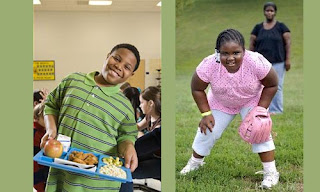Why Children Are Getting Adult Illnesses
Parents
should be concerned about the developing trend of obesity, type II diabetes,
heart disease and other serious conditions among children under eighteen. It
was unheard of several years ago for a child to be diagnosed with any of these
diet-related illnesses. Unfortunately
these days the issue is quite prevalent, which is worrying. The next two questions to ask therefore are: What
has changed presently? Why are children getting what is normally called 'adult'
illnesses? There are several reasons responsible for this worrying trend.
First,
children are becoming unhealthy because parents are busier and more stressed
than ever, reducing the time they should spend making wholesome meals. In the
1950’s and 1960’s, there were more stay- at- home wives and mothers than presently.
By staying at home, mothers were able to spend more time preparing healthy and
nutritious meals every day. But now, with the fast rising cost of living, more
and more mothers have no choice but to go out and work because an extra income
will boost the families’ finance making survival less stressful. Consequently, children
are either left to eat processed and prepackaged foods that their parents
quickly throw together, or put a few grubs together for themselves. It shouldn’t
be a surprise the type of food children will pick when left to care for themselves.
It’s going to be junk food because it’s quick, easy and taste great. For
instance fast food like instant noodles, potato fries, hot dogs, pizza,
pastries, fried chicken, chicken wraps, doughnuts, hamburgers, cookies, cakes
and sodas are on top of many children’s and teenagers’ list of preferred foods.
Second, considering the fact that school children are in school almost forty hours a
week, parents definitely shouldn’t take all the blame for the unhealthy state
of their children. A high portion of food served at schools offer high calories
with small nutritional value. Many schools' diet don’t meet the nutritional
recommendations of eating at least five servings a day of fruits and vegetables
with no more than 30% of calories from fat. It behooves the school to teach the
children not only academics but also how to eat properly. The schools need to
educate the children on what could happen to their health and bodies if they
eat unhealthy foods on a regular basis. As such, schools should serve natural and
healthy foods and not junk food often laden with saturated fats and high
sodium.
Gradually
substituting unhealthful foods with healthier versions would be a great way for
schools to provide more nutritious menus for school children. It could start
out as small as replacing the fried chicken with skinless roast chicken, roast
potatoes or steamed rice, and green vegetables, instead of fried chips. Most
kids wouldn’t even notice, and the skinless
chicken means less fat, while the extra vegetables means increased fiber in
their diets, which supply them with some much-needed B vitamins. Parents
would probably gladly pay for the extra if it’s about cost so long as they know
it will improve the health benefits of the meals that the school serve, and in
the end benefit their children also.
Even
though the school takes the major responsibility for the increase in
diet-related illness in children, parents too share the blame. Many parents
while shopping fill their baskets with sugary juices, soft drinks, frozen
dinners, cakes, cookies, candy, and other junk that is totally void of any type
of nutritional value. There are unnecessary and potentially dangerous
ingredients in many foods that we eat on a daily basis: preservatives, dyes,
and other harmful chemicals, just to name a few. These harmful ingredients
build up in the body and can cause an array of possibly debilitating ailments.
Certainly you don’t want your kids consuming these types of foods that will
cause them to possibly develop allergies and sensitivities, or any other
condition. In cases where children take their own lunch boxes to school, it is
the responsibility of the parents to pack healthy nutritious meals, snacks, water, and
fruits. The parents should ensure their children eat healthy 99% of the time.
And if
per chance the school continues to serve fattening and unwholesome lunches,
then you as a parent should carry on preparing preservative-free sandwiches on
whole grain bread with raw chopped vegetables, fresh fruit, nuts and other
nutritious foods. This is not saying that children cannot eat pizza, ice cream,
have KFC with friends, or eat some birthday cake every now and then. You don’t have
to deprive your children of occasional 'treats,' but because you have taken the
time to educate them on the importance of proper nutrition, they would soon
begin to prefer homemade dishes to fast food restaurants dishes. So when they
do request a KFC meal, or other 'forbidden food,' you’ll grant their request, knowing
it’s an occasional treat.
Lastly,
granting many children are developing risky and life-threatening diet-related illnesses,
which until now are exclusively adult-related, it will be erroneous to think it’s
one person’s responsibility to ensure that children eat healthy and get
adequate amounts of exercise. No it’s not.
It’s the responsibility of everyone involved in a child's life: parents,
teachers, house helps, and whoever else has frequent contact with the children.
Photo
Credit: Creative Commons








Comments
Post a Comment